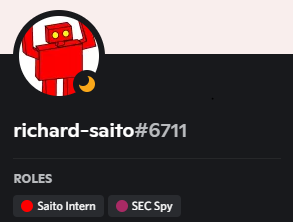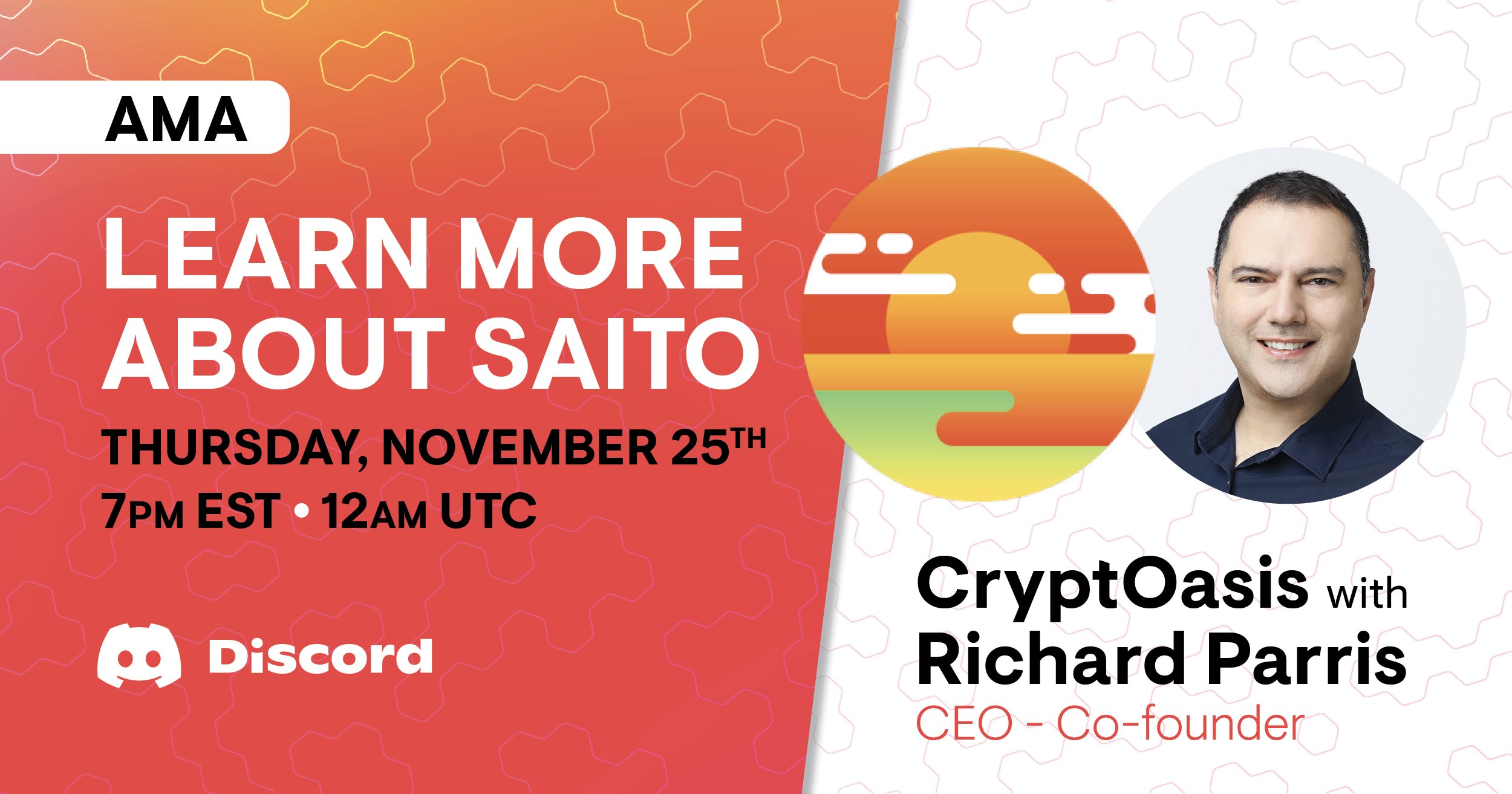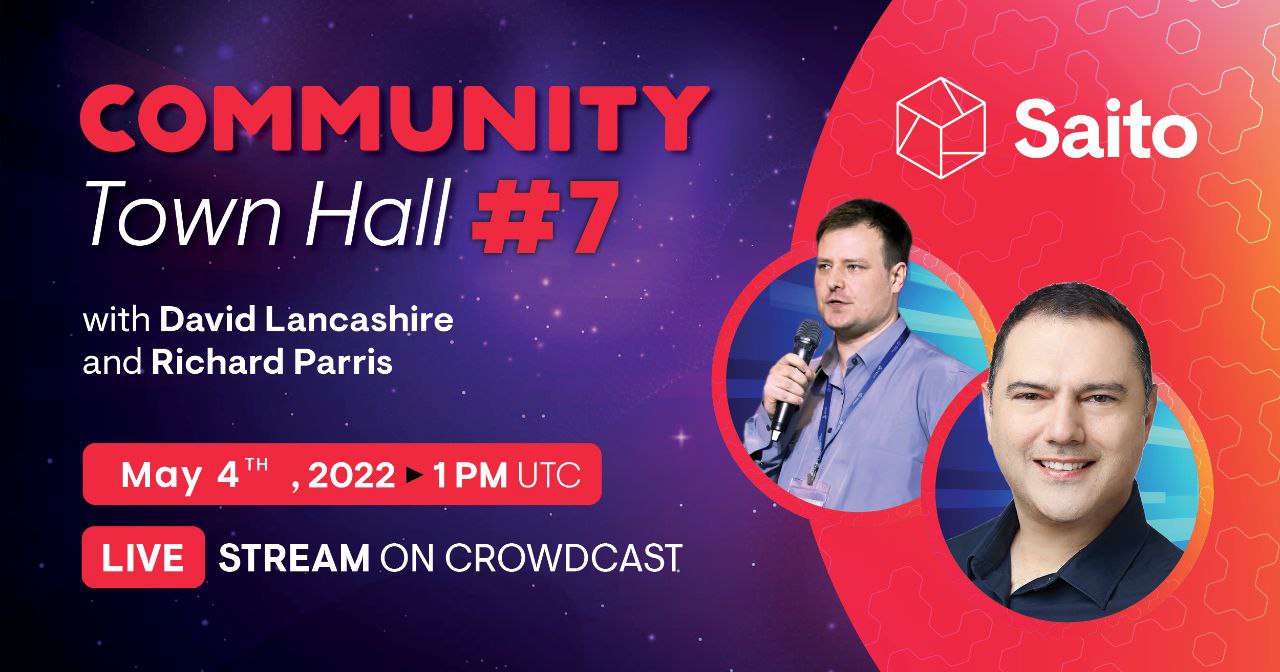CryptOasis AMA Transcript
Recently, Saito’s Co-founder Richard Parris had a long awaited AMA with the CryptOasis community, hosted by GreenWeeny, a prominent member of the Saito Community. Here’s a full transcript of what went down on their Discord server:
GreenWeeny: Hey hey everyone, I’m excited to have Richard Parris here with us for this text AMA! I know we have a lot of Saito maxis here, so I hope you all are as excited as I am. Welcome, Richard!
I gotta warn you, there’s a lot of Solana maxis here as well. So you are kinda in the lion’s den.
Richard: I grew up when there were only Bitcoin Maxis.
GreenWeeny: How quickly the crypto space is changing.
Richard: Tell me about it.
GreenWeeny: Anyway, I really appreciate you taking the time to be here again and I’m looking forward to this discussion!
Richard: Always happy to chat Saito with the communiteh.
GreenWeeny: Awesome. To start off, can you introduce yourself to the people here who don’t already know who you are and what Saito is? How did you get involved in crypto and how did Saito come to be born?
Richard: So, Bitcoin Maxis, from when that’s all there was. David and I were both in the Beijing tech scene from 2007-2008 or so. CTOs of our relative startups. We kinda knew each other from tech but met properly through the BTC meetups in Beijing. Think he started going in 2012 and me in 2013…
This is really relevant to Saito for two reasons.
– For me when I saw Bitcoin for the first time I was at least as interested or more interested in Bitcoin as a messaging network, Web3, as I was about the money thing.
– We watched as scaling became a side topic, then a central topic to something that ripped the community apart.
Saito was born out of these two factors. Wanting to build an independent (no owner) network that created a space for genuine P2P applications and something that could scale to do it.
GreenWeeny: Cool. I’m curious, and I think others are too, what brought you and David to China? Correct me if I’m wrong but you are from South Africa? And I believe David is Canadian?
Richard: I was born in SA and grew up in Melbourne, Australia. David came out to do a Chinese language study semester/course which was part of his studies at Berkeley. I was working in tech – Risk and Compliance software in banks in Australia after studying Philosophy and Mathematics for… well, a long time. So I was after something more challenging and rewarding than… deploying software in banks. China was a stop on the way to Europe looking for a new role. It’s been 15 years now. Lucky as the Bitcoin scene in Beijing was awesome from 2012 to 2017, most of the biggest companies, exchanges, miners, etc. were here.
GreenWeeny: One of the common misconceptions about Saito I see is that newcomers think it’s a “Polkadot project” or “Polkadot token.” Can you explain what kind of role or roles that Saito would like to play in the Polkadot ecosystem?
Richard: So the Web3 Foundation/Polkadot Ecosystem collaboration has been really great for us. It’s gotten the project in front of a lot of folks and given us opportunities to present and talk about Saito we would not have had otherwise. But it’s a collaboration, we are independent.
In the end, we would like to do some reclaiming of Web3 as a concept from the Polkadot guys. Gavin Wood has done a pretty good job of ‘owning it’ but it predates even Ethereum as an idea. It is an idea we are committed to though. Saito can help dot ecosystem, and other PoW and PoS chains by providing a data network that is independent. This is important as no one has a solution to this.
When you use Uniswap, you are hitting a lot of Web2 architecture. Client-server websites that are owned and operated by companies or projects even individuals. It’s not their ownership that is really at issue, though, it’s that you can’t move between providers. And even when the platforms are open source – to create a competitor you have to overcome commercial and technical moats. Saito aims to move to genuinely peer-to-peer options, breaking apart interfaces from data stores and infrastructure providers to end that. And make it possible for people to transact, play, work, etc. together in an entirely P2P way without any trusted third parties.
GreenWeeny: Great. I know a lot of different blockchain projects talk a lot about Web3. (Solana, Ethereum, Zilliqa, DOT, etc.) Why did you all choose to work with the Polkadot community over other major blockchain players?
Richard: One reason was the grants scheme. This gave us a way to reach out and collaborate on something. Another was the openness of the community and their quick understanding of how we could help. As the parachain project mature, Dot (substrate) devs are starting to look to deployment. Many are Eth devs who have moved on. They reach for tools like Etherscan and Infura and they just aren’t there for Dot. Folks have written the software, but no one is providing free service. So, they see the need for Saito very quickly.
GreenWeeny: With the Rust client joining the network by EOM, are there any other big happenings coming up that you can talk about? What’s the next big step for Saito? Anything you can hint or sneak peek at?
Richard: I think the biggest thing we are working on is making it simpler to integrate ‘any crypto’ the way we did DOT/KUSAMA for the Dotarcade. This will be huge in allowing us to take Saito to other communities, and to have real collaborations. It is also the first step in getting builders to create apps that have real users and build their businesses and business models around them.
GreenWeeny: How would you explain what Saito does to someone that is new or doesn’t know much about crypto?
Richard: There are a lot of different ways and the best depends on their approach to crypto. A good one is to play ‘spot the volunteer’. With every PoS, dPoS, and PoW network (all others we have spotted) there is a volunteer group. In BTC, it’s the P2P network nodes. They are not paid and BTC is consequently restricted to the capacity that volunteers are prepared to provide. In ETH it’s Joe Lubin and Infura – that provide essential services to make Eth dev possible. In a lot of chains, it’s the center handing out money for these things, to make it possible. (Juicing staking or validator rewards beyond fees). Saito fixes this. It creates a network where everyone is paid, and anyone doing anything useful can be profitable. There are other ones, but that’s a good way to start.
GreenWeeny: This is a great answer. I know that’s one thing new people in the community struggle with a bit is trying to break Saito down Barney style to people not in it yet!
Richard: Starting with what it does, functionally, internally is wrong, because most of the industry is just tweaking versions of this, but not in a way that changes the fundamentals, so it’s harder to get to what’s revolutionary about Saito.
GreenWeeny: Speaking of diving a bit more into how Saito works functionally, let’s do this question from our member, Midnight; Is there any concern about a few big players running multiple nodes and dominating Saito, causing the same centralization Saito seeks to solve? If that is a concern is there any mechanism to prevent this?
https://wyomingblockchainstampede.sched.com/speaker/shirley124
So, David has spoken directly on this in a couple of places. Saito believes there are always centralizing pressures. Fighting them head-on is a battle against physics and economics, that you can’t necessarily win. Our approach is to ask – why do we want decentralization and how do we get that?
It turns out that if you ask the first part of that question a lot of folks are assuming decentralization is good in itself. But the SWIFT network, for example, is decentralized, but not at all open. It’s banking, not blockchain. What we are hoping to get from decentralization is mostly openness, the property that anyone can participate, no one can be blocked from entering. And self-sufficiency, that the network operates for and by itself, so it is not dependent on anyone to keep going. Here it’s important to see that properties that almost no one talks about, like universal broadcast, are important. I can send a transaction to anyone on the BTC chain, or ETH by their address alone. No one can stop me. This is a super important property – and one that is lost when you go to sharding and to DAGS and other BFT structures. And looping back around, if a network is always open, then if someone does come in and start dominating, at least it is always possible for others to enter, so the ground is fertile for natural decentralization. I encourage folks to follow up on that piece and video from David, they make this point better than I can here.
GreenWeeny: Yeah I’ll leave those there for people to wrap their heads around after reading that answer! The next question is from Supah.sol; How will you attract developers to Saito to build on your platform? What is your pitch if a developer asks why they should build on Saito over another blockchain?
Richard: Dollah, dollah bills. By that I mean, the ability to have a functioning business model through the code itself. Once upon a time, people were excited about ‘micropayments’ with crypto. This was seen as a huge part of Web3, and allowing providers to create great software and get paid for it. Saito transactions can fit in whole transactions from other networks and can even bundle them. This gives nearly infinite variety in was that payment can be part of activities, even at tiny levels within Saito applications. An example would be a game where the publisher gets ‘cents’ per play. Or a music blog where the blogger splits the streaming fee directly with the artist. Best of all, if that’s ad-driven, the user got 100% of the ad revenue and used that to pay the artist and the blogger. (Right now, it costs Google less than 1% of what they get to provide the service and they pay around 5% to the host).
It’s going to be the ability to do this AND not worry about the infrastructure, just get your software out there and users hit the nodes of their choice, that will win the day. Bootstrapping this is a large part of the roadmap.
GreenWeeny: Graham from the Telegram asks; (King) Richard, are you surprised at how the community has grown around Saito? I see other projects that have been around far longer without anywhere near as much buzz.
Richard: Yes, and no. No, in that we have long been pointing out that Saito now is like BTC in 2011. If people agree (and they seem to) then of course people are going to get excited about that. I am surprised about it though in some ways. You never know what something will look like till it exists, so I had not anticipated just how cool the community would be. And, how active. It’s also been an ‘it never rains then it pours’ thing.
We’ve been at this for a long time, especially in crypto time. So even though we have been sticking to our guns, confident that what we are doing will appeal to folks and to not water it down, to stick to our path, it’s still surprising when it happens. It’s created a massive buzz in the project and the industry. And it certainly gets the founders and team pumped.
GreenWeeny: That was one of the biggest things that stood out about the Saito community when I first found it. How active and not shitcoiny it was. Love it
Richard: Us too.
GreenWeeny: Great. I think these last two questions should be pretty easy. The first one is from Mose: From listening to a few of the townhalls I gained the impression that you guys are a bit wary of CEX listings (forgive me if this is an incorrect presumption on my part). I’m aware of the recent developments regarding Pancakeswap liquidity so I have to ask, what other plans do you guys have regarding making the Saito token more easily accessible?
Richard: Good Q. We are wary in as much as there is an assumption that Binance=riches for everyone. Price growth for us, I think, has come from the adoption of the fundamental ideas. An exchange does not do that for you. Listings, traditionally, involve dumping big tranches of tokens on exchanges that they dump and or hand out for the resulting volume. Unless you execute that well, or you do a metric ton of shitcoining, it is a burden on the project moving forward. We are talking to exchanges and connections in the industry and looking for CEX options that don’t have those negative effects, and doing things like talking to funds about providing liquidity for listing – rather than dumping more Saito into the market. We are also talking to groups like Changelly, who have lower fees but centralized buying options. Our strategy is to work toward lower fees for purchasers, fiat on-ramps, more integrations with other chains and ecosystems creating more ways to convert, and trying to minimize the amount of SAITO being dumped into the market while that happens.
GreenWeeny: Thanks Richard. I know wen CEX is always on people’s minds. Love to hear that you all take the protecting investors approach.
Richard: We don’t hate CEXs but a listing needs to be a net and long-term gain.
GreenWeeny: Last question! From our favorite Saito maxi, JOJ (Georgex5): In the recent roadmap, you defer the matter of releasing or burning mainnet tokens until the era of the “Real Economy,” what are the factors that you foresee determining whether the “real-world Saito economy” will need more tokens distributed or otherwise burned?
Richard: Big George! Talking above about business models for builders and the economy, you can see we have a bootstrapping issue. Saito does not have a block reward, by design, it’s how we solve the 51% attack and the economics generally. But this leaves us with a challenge. Making node operation profitable out of user fees from the beginning. We have a few ways we can approach that. One is as an initial sponsor – running some community nodes with project money. That will be a necessary step to get folks going but does not solve the longer term problem of boostrapping the economy, getting the flywheel spinning. An advertising faucet is a great way to do that and will be one part of our strategy. This would create a way to give users tokens to spend on the network, for using the network. These could be project ads, just notices and the like, but would also hopefully move to being commercial at some point. Real advertisers buying Saito to give to users, to pay fees.
Now, it’s quick to see that if that kind of system is too generous, you are just dumping tokens in, and creating inflation. If it is not generous enough, there won’t be enough impact to get anything serious happening. So, these programs will need monitoring and careful execution. (We anticipate that they will be done well enough that some major holders, not just the project will do this kind of thing.) What percentage of tokens are needed to make this work? it’s hard to judge. As that becomes clear – burning tokens will be a powerful way to increase the good effects of things like the faucet. Hence this needing to be done at a later stage. Hope that sheds some light.
GreenWeeny: I believe it does. Thanks! And with that we’ll go ahead and wrap up
Richard: Thanks everyone!!!
GreenWeeny: Thanks so much Richard for taking the time to be here. Great questions and great answers, and maybe a few new Saito maxis.
Richard: Yes, this was a really great AMA. Solid questions. I hope good answers.
GreenWeeny: Would love to do this again sometime. I really enjoyed it.
Richard: Let’s do it. And let’s get Mr. Lancashire on the Pod if we can! He has a podding background and a voice for radio.
GreenWeeny: Great! I know we’ll be in touch so we shall figure something out! I know we’d love to get Davit onto the podcast.
Richard: He has a podding background and a voice for radio.
GreenWeeny: He really does haha
Richard: If you want to learn Chinese and like listening to David, popupchinese.com. Just saying, you can mainline David there.
GreenWeeny: Good to know. Thanks again Richard! Looking forward to speaking soon.
Richard: Thanks again everyone – great to be here. Loving my status.

GreenWeeny: If David comes in here, we’ll give him the same
Richard: Excellent.




